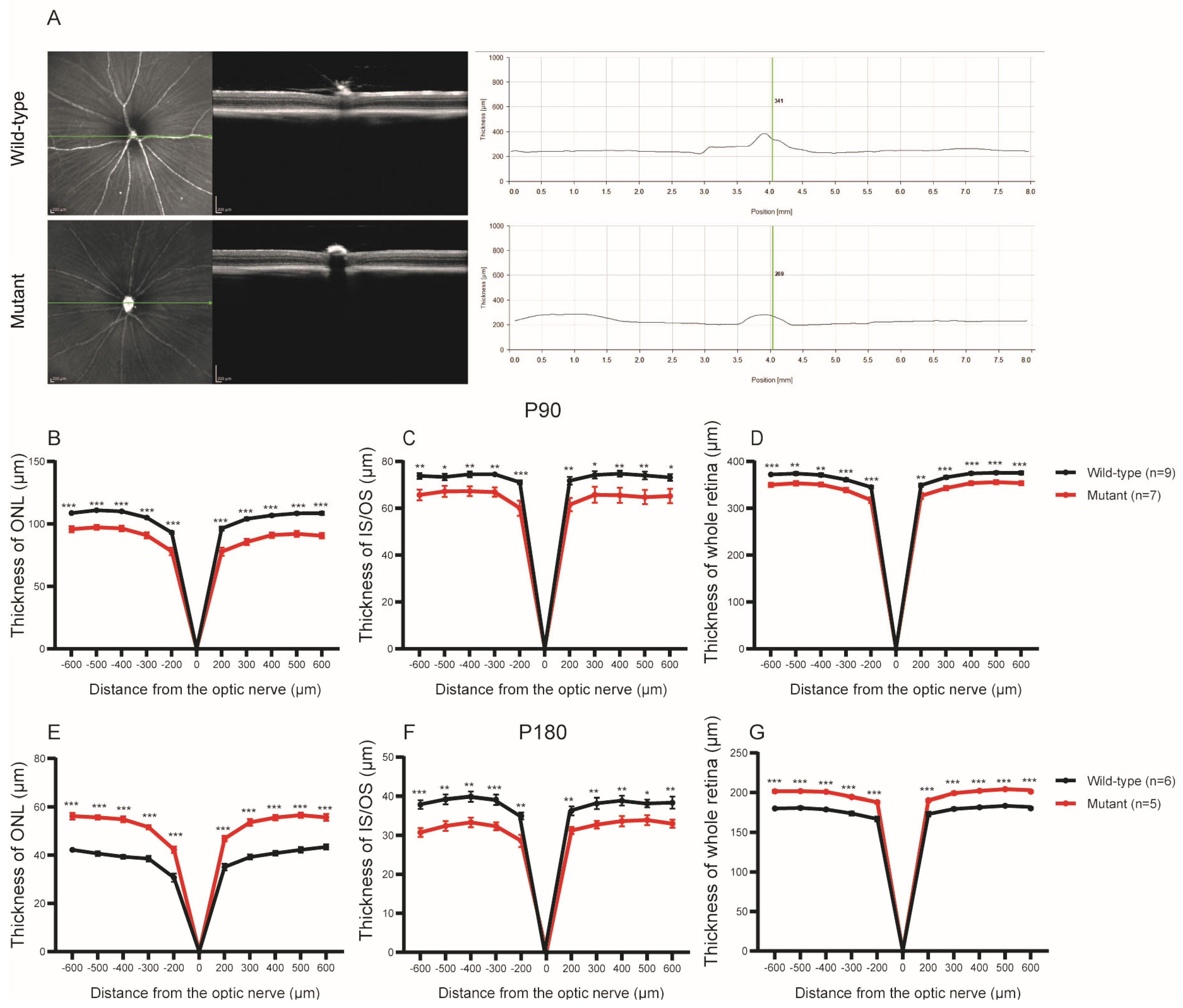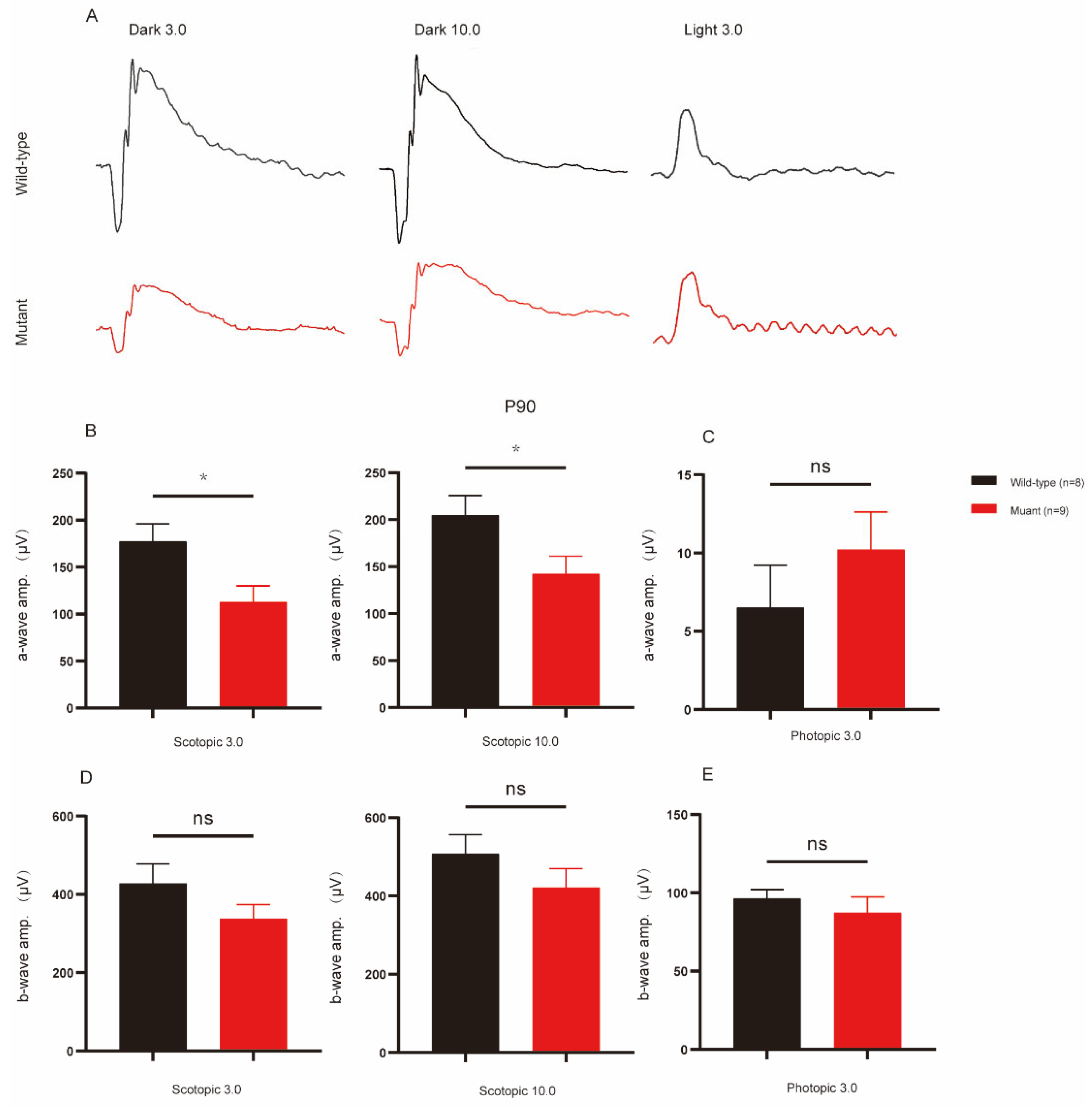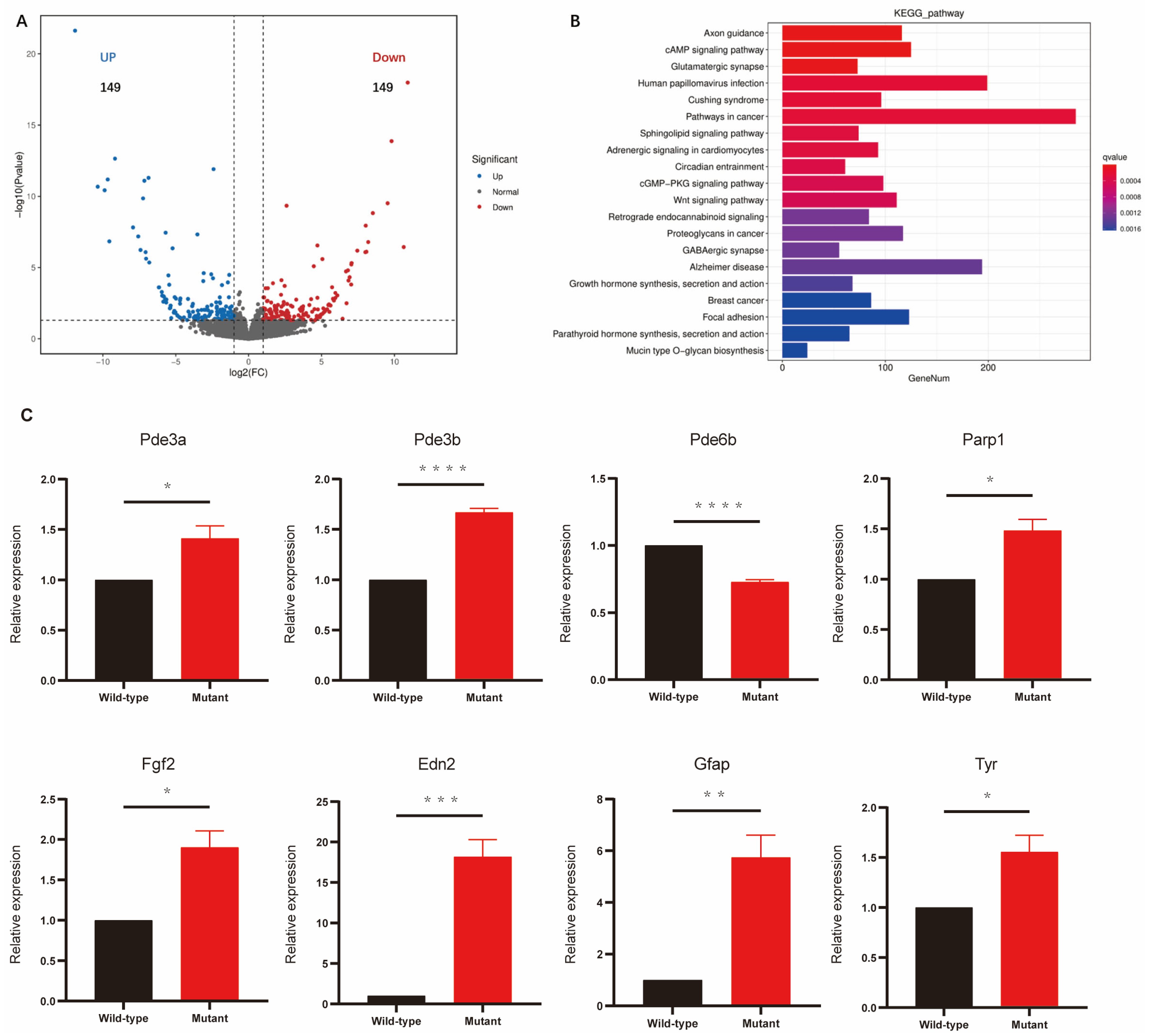RNA-Seq Analysis Reveals an Essential Role of the cGMP-PKG-MAPK Pathways in Retinal Degeneration Caused by Cep250 Deficiency
Abstract
1. Introduction
2. Results
2.1. Retinal Structure Changes Cep250 Mice
2.2. Impairment of Retina Function in Cep250 Mice
2.3. Reduction of Cone and Rod Photoreceptors in Cep250 Retinas
2.4. RNA-Sequencing Analysis of Molecular Changes in Cep250 Mice Retinas
3. Discussion
4. Materials and Methods
4.1. Animals
4.2. Aminal Care
4.3. Optical Coherence Tomography Image Acquisition and Analysis
4.4. Electroretinogram
4.5. Immunohistochemistry and TUNEL Staining
4.6. RNA Sequencing
4.7. Quantitative Real-Time PCR (qRT-PCR)
4.8. Data Analysis
5. Conclusions
Supplementary Materials
Author Contributions
Funding
Institutional Review Board Statement
Informed Consent Statement
Data Availability Statement
Acknowledgments
Conflicts of Interest
References
- Schneider, N.; Sundaresan, Y.; Gopalakrishnan, P.; Beryozkin, A.; Hanany, M.; Levanon, E.Y.; Banin, E.; Ben-Aroya, S.; Sharon, D. Inherited retinal diseases: Linking genes, disease-causing variants, and relevant therapeutic modalities. Prog. Retin. Eye Res. 2022, 89, 101029. [Google Scholar] [CrossRef]
- Newton, F.; Megaw, R. Mechanisms of Photoreceptor Death in Retinitis Pigmentosa. Genes 2020, 11, 1120. [Google Scholar] [CrossRef]
- Verbakel, S.K.; van Huet, R.A.C.; Boon, C.J.F.; den Hollander, A.I.; Collin, R.W.J.; Klaver, C.C.W.; Hoyng, C.B.; Roepman, R.; Klevering, B.J. Non-syndromic retinitis pigmentosa. Prog. Retin. Eye Res. 2018, 66, 157–186. [Google Scholar] [CrossRef]
- Millan, J.M.; Aller, E.; Jaijo, T.; Blanco-Kelly, F.; Gimenez-Pardo, A.; Ayuso, C. An update on the genetics of usher syndrome. J. Ophthalmol. 2011, 2011, 417217. [Google Scholar] [CrossRef]
- Fuster-Garcia, C.; Garcia-Bohorquez, B.; Rodriguez-Munoz, A.; Aller, E.; Jaijo, T.; Millan, J.M.; Garcia-Garcia, G. Usher Syndrome: Genetics of a Human Ciliopathy. Int. J. Mol. Sci. 2021, 22, 6723. [Google Scholar] [CrossRef]
- De Joya, E.M.; Colbert, B.M.; Tang, P.C.; Lam, B.L.; Yang, J.; Blanton, S.H.; Dykxhoorn, D.M.; Liu, X. Usher Syndrome in the Inner Ear: Etiologies and Advances in Gene Therapy. Int. J. Mol. Sci. 2021, 22, 3910. [Google Scholar] [CrossRef] [PubMed]
- Toms, M.; Pagarkar, W.; Moosajee, M. Usher syndrome: Clinical features, molecular genetics and advancing therapeutics. Ther. Adv. Ophthalmol. 2020, 12, 2515841420952194. [Google Scholar] [CrossRef]
- Abu-Diab, A.; Gopalakrishnan, P.; Matsevich, C.; de Jong, M.; Obolensky, A.; Khalaileh, A.; Salameh, M.; Ejzenberg, A.; Gross, M.; Banin, E.; et al. Homozygous Knockout of Cep250 Leads to a Relatively Late-Onset Retinal Degeneration and Sensorineural Hearing Loss in Mice. Transl. Vis. Sci. Technol. 2023, 12, 3. [Google Scholar] [CrossRef] [PubMed]
- Dang, H.; Martin-Villalba, A.; Schiebel, E. Centrosome linker protein C-Nap1 maintains stem cells in mouse testes. EMBO Rep. 2022, 23, e53805. [Google Scholar] [CrossRef]
- Rao, K.N.; Zhang, W.; Li, L.; Ronquillo, C.; Baehr, W.; Khanna, H. Ciliopathy-associated protein CEP290 modifies the severity of retinal degeneration due to loss of RPGR. Hum. Mol. Genet. 2016, 25, 2005–2012. [Google Scholar] [CrossRef] [PubMed]
- Reed, M.; Takemaru, K.I.; Ying, G.; Frederick, J.M.; Baehr, W. Deletion of CEP164 in mouse photoreceptors post-ciliogenesis interrupts ciliary intraflagellar transport (IFT). PLoS Genet. 2022, 18, e1010154. [Google Scholar] [CrossRef]
- Cervenka, I.; Valnohova, J.; Bernatik, O.; Harnos, J.; Radsetoulal, M.; Sedova, K.; Hanakova, K.; Potesil, D.; Sedlackova, M.; Salasova, A.; et al. Dishevelled is a NEK2 kinase substrate controlling dynamics of centrosomal linker proteins. Proc. Natl. Acad. Sci. USA 2016, 113, 9304–9309. [Google Scholar] [CrossRef] [PubMed]
- Zeng, L.; Fan, X.; Wang, X.; Deng, H.; Zhang, X.; Zhang, K.; He, S.; Li, N.; Han, Q.; Liu, Z. Involvement of NEK2 and its interaction with NDC80 and CEP250 in hepatocellular carcinoma. BMC Med. Genom. 2020, 13, 158. [Google Scholar] [CrossRef]
- Khateb, S.; Zelinger, L.; Mizrahi-Meissonnier, L.; Ayuso, C.; Koenekoop, R.K.; Laxer, U.; Gross, M.; Banin, E.; Sharon, D. A homozygous nonsense CEP250 mutation combined with a heterozygous nonsense C2orf71 mutation is associated with atypical Usher syndrome. J. Med. Genet. 2014, 51, 460–469. [Google Scholar] [CrossRef]
- de Castro-Miro, M.; Tonda, R.; Escudero-Ferruz, P.; Andres, R.; Mayor-Lorenzo, A.; Castro, J.; Ciccioli, M.; Hidalgo, D.A.; Rodriguez-Ezcurra, J.J.; Farrando, J.; et al. Novel Candidate Genes and a Wide Spectrum of Structural and Point Mutations Responsible for Inherited Retinal Dystrophies Revealed by Exome Sequencing. PLoS ONE 2016, 11, e0168966. [Google Scholar] [CrossRef]
- Kubota, D.; Gocho, K.; Kikuchi, S.; Akeo, K.; Miura, M.; Yamaki, K.; Takahashi, H.; Kameya, S. CEP250 mutations associated with mild cone-rod dystrophy and sensorineural hearing loss in a Japanese family. Ophthalmic. Genet. 2018, 39, 500–507. [Google Scholar] [CrossRef]
- Huang, X.F.; Xiang, L.; Fang, X.L.; Liu, W.Q.; Zhuang, Y.Y.; Chen, Z.J.; Shen, R.J.; Cheng, W.; Han, R.Y.; Zheng, S.S.; et al. Functional characterization of CEP250 variant identified in nonsyndromic retinitis pigmentosa. Hum Mutat 2019, 40, 1039–1045. [Google Scholar] [CrossRef]
- Power, M.; Das, S.; Schutze, K.; Marigo, V.; Ekstrom, P.; Paquet-Durand, F. Cellular mechanisms of hereditary photoreceptor degeneration—Focus on cGMP. Prog. Retin. Eye Res. 2020, 74, 100772. [Google Scholar] [CrossRef]
- Cote, R.H. Characteristics of photoreceptor PDE (PDE6): Similarities and differences to PDE5. Int J Impot Res 2004, 16 (Suppl. S1), S28–S33. [Google Scholar] [CrossRef] [PubMed]
- Muradov, H.; Boyd, K.K.; Kerov, V.; Artemyev, N.O. Atypical retinal degeneration 3 in mice is caused by defective PDE6B pre-mRNA splicing. Vision Res. 2012, 57, 1–8. [Google Scholar] [CrossRef] [PubMed]
- Dvir, L.; Srour, G.; Abu-Ras, R.; Miller, B.; Shalev, S.A.; Ben-Yosef, T. Autosomal-recessive early-onset retinitis pigmentosa caused by a mutation in PDE6G, the gene encoding the gamma subunit of rod cGMP phosphodiesterase. Am. J. Hum. Genet. 2010, 87, 258–264. [Google Scholar] [CrossRef]
- Corton, M.; Blanco, M.J.; Torres, M.; Sanchez-Salorio, M.; Carracedo, A.; Brion, M. Identification of a novel mutation in the human PDE6A gene in autosomal recessive retinitis pigmentosa: Homology with the nmf28/nmf28 mice model. Clin. Genet. 2010, 78, 495–498. [Google Scholar] [CrossRef] [PubMed]
- Roy, A.; Tolone, A.; Hilhorst, R.; Groten, J.; Tomar, T.; Paquet-Durand, F. Kinase activity profiling identifies putative downstream targets of cGMP/PKG signaling in inherited retinal neurodegeneration. Cell Death Discov. 2022, 8, 93. [Google Scholar] [CrossRef]
- Dong, Y.; Xu, W.; Li, Y.; Wei, C.; Hu, Y.; Hu, Z.; Paquet-Durand, F.; Jiao, K. Inhibition of the MAPK/c-Jun-EGR1 Pathway Decreases Photoreceptor Cell Death in the rd1 Mouse Model for Inherited Retinal Degeneration. Int. J. Mol. Sci. 2022, 23, 14600. [Google Scholar] [CrossRef] [PubMed]
- Ueki, Y.; Wang, J.; Chollangi, S.; Ash, J.D. STAT3 activation in photoreceptors by leukemia inhibitory factor is associated with protection from light damage. J. Neurochem. 2008, 105, 784–796. [Google Scholar] [CrossRef]
- Joly, S.; Lange, C.; Thiersch, M.; Samardzija, M.; Grimm, C. Leukemia inhibitory factor extends the lifespan of injured photoreceptors in vivo. J. Neurosci. 2008, 28, 13765–13774. [Google Scholar] [CrossRef]
- Samardzija, M.; Wariwoda, H.; Imsand, C.; Huber, P.; Heynen, S.R.; Gubler, A.; Grimm, C. Activation of survival pathways in the degenerating retina of rd10 mice. Exp. Eye. Res. 2012, 99, 17–26. [Google Scholar] [CrossRef] [PubMed]
- Kassumeh, S.; Leopold, S.; Fuchshofer, R.; Thomas, C.N.; Priglinger, S.G.; Tamm, E.R.; Ohlmann, A. Norrin Protects Retinal Ganglion Cells from Excitotoxic Damage via the Induction of Leukemia Inhibitory Factor. Cells 2020, 9, 277. [Google Scholar] [CrossRef]
- Sel, S.; Patzel, E.; Poggi, L.; Kaiser, D.; Kalinski, T.; Schicht, M.; Paulsen, F.; Nass, N. Temporal and spatial expression pattern of Nnat during mouse eye development. Gene Expr. Patterns 2017, 23–24, 7–12. [Google Scholar] [CrossRef]
- Shinde, V.; Pitale, P.M.; Howse, W.; Gorbatyuk, O.; Gorbatyuk, M. Neuronatin is a stress-responsive protein of rod photoreceptors. Neuroscience 2016, 328, 1–8. [Google Scholar] [CrossRef] [PubMed]
- Chiha, W.; LeVaillant, C.J.; Bartlett, C.A.; Hewitt, A.W.; Melton, P.E.; Fitzgerald, M.; Harvey, A.R. Retinal genes are differentially expressed in areas of primary versus secondary degeneration following partial optic nerve injury. PLoS ONE 2018, 13, e0192348. [Google Scholar] [CrossRef]
- Seruggia, D.; Josa, S.; Fernandez, A.; Montoliu, L. The structure and function of the mouse tyrosinase locus. Pigment. Cell Melanoma Res. 2021, 34, 212–221. [Google Scholar] [CrossRef] [PubMed]
- Zeng, L.; Li, X.; Liu, J.; Liu, H.; Xu, H.; Yang, Z. RNA-Seq Analysis Reveals an Essential Role of the Tyrosine Metabolic Pathway and Inflammation in Myopia-Induced Retinal Degeneration in Guinea Pigs. Int. J. Mol. Sci. 2021, 22, 12598. [Google Scholar] [CrossRef] [PubMed]
- Wagenaar-Bos, I.G.; Hack, C.E. Structure and function of C1-inhibitor. Immunol. Allergy Clin. North Am. 2006, 26, 615–632. [Google Scholar] [CrossRef] [PubMed]
- Mullins, R.F.; Faidley, E.A.; Daggett, H.T.; Jomary, C.; Lotery, A.J.; Stone, E.M. Localization of complement 1 inhibitor (C1INH/SERPING1) in human eyes with age-related macular degeneration. Exp. Eye Res. 2009, 89, 767–773. [Google Scholar] [CrossRef]
- Templeton, J.P.; Freeman, N.E.; Nickerson, J.M.; Jablonski, M.M.; Rex, T.S.; Williams, R.W.; Geisert, E.E. Innate immune network in the retina activated by optic nerve crush. Investig. Opthalmology Vis. Sci. 2013, 54, 2599–2606. [Google Scholar] [CrossRef]
- Liao, Y.; Wang, J.; Jaehnig, E.J.; Shi, Z.; Zhang, B. WebGestalt 2019: Gene set analysis toolkit with revamped UIs and APIs. Nucleic Acids Res. 2019, 47, W199–W205. [Google Scholar] [CrossRef] [PubMed]
- Raudvere, U.; Kolberg, L.; Kuzmin, I.; Arak, T.; Adler, P.; Peterson, H.; Vilo, J. g:Profiler: A web server for functional enrichment analysis and conversions of gene lists (2019 update). Nucleic Acids Res. 2019, 47, W191–W198. [Google Scholar] [CrossRef]




| Top 15 Upregulated Genes | Top 15 Downregulated Genes | ||||||
|---|---|---|---|---|---|---|---|
| Symbol | Log2(FC) | p-Value | Description | Symbol | Log2(FC) | p-Value | Description |
| Edn2 | 3.905 | 8.609 × 1028 | endothelin-2 preproprotein | Cryaa | −6.122 | 0.015 | alpha-crystallin A |
| Lad1 | 2.757 | 3.49 × 1014 | ladinin-1 | Crygs | −5.453 | 0.048 | gamma-crystallin S |
| Cyp4f15 | 2.184 | 0.003 | cytochrome P450 | Cryba1 | −5.411 | 0.028 | beta-crystallin A1 |
| Dio3 | 2.136 | 0.001 | thyroxine 5-deiodinase | Crybb1 | −4.558 | 0.012 | beta-crystallin B1 |
| C4b | 1.965 | 0.0002 | complement C4-B | Cryab | −2.889 | 0.037 | alpha-crystallin B |
| Itgam | 1.802 | 0.0008 | integrin alpha-M | Nid1 | −2.543 | 0.047 | nidogen-1 |
| Tyr | 1.761 | 5.617 × 106 | tyrosinase isoform 1 | Cd24a | −2.153 | 0.049 | signal transducer CD24 |
| Xlr3a | 1.678 | 0.0009 | mCG114264, isoform CRA_b | Zbed6 | −2.081 | 0.026 | zinc finger BED domain |
| A2m | 1.606 | 1.609 × 1011 | alpha-2-macroglobulin-P | Lamb3 | −1.704 | 0.003 | laminin subunit beta-3 |
| Dsg1a | 1.566 | 0.0009 | desmoglein-1-alpha preproprotein | Cdh1 | −1.613 | 0.002 | cadherin-1 preproprotein |
| Cpt1b | 1.551 | 5.046 × 105 | carnitine O-palmitoyltransferase 1 | Scand1 | −1.600 | 0.007 | SCAN domain |
| Gfap | 1.524 | 1.434 × 108 | glial fibrillary acidic protein | Rps27 | −1.511 | 0.015 | 40S ribosomal |
| Thbs2 | 1.490 | 0.025 | thrombospondin-2 | Lrrc3b | −1.321 | 0.010 | leucine-rich repeat |
| Zic4 | 1.484 | 0.017 | zinc finger protein 4 | Hba-a1 | −1.206 | 0.006 | hemoglobin alpha |
| Cldn1 | 1.483 | 3.946 × 105 | claudin-1 | Lgals3 | −1.203 | 0.025 | galectin-3 |
Disclaimer/Publisher’s Note: The statements, opinions and data contained in all publications are solely those of the individual author(s) and contributor(s) and not of MDPI and/or the editor(s). MDPI and/or the editor(s) disclaim responsibility for any injury to people or property resulting from any ideas, methods, instructions or products referred to in the content. |
© 2023 by the authors. Licensee MDPI, Basel, Switzerland. This article is an open access article distributed under the terms and conditions of the Creative Commons Attribution (CC BY) license (https://creativecommons.org/licenses/by/4.0/).
Share and Cite
Chen, C.; Rong, Y.; Zhuang, Y.; Tang, C.; Liu, Q.; Lin, P.; Li, D.; Zhao, X.; Lu, F.; Qu, J.; et al. RNA-Seq Analysis Reveals an Essential Role of the cGMP-PKG-MAPK Pathways in Retinal Degeneration Caused by Cep250 Deficiency. Int. J. Mol. Sci. 2023, 24, 8843. https://doi.org/10.3390/ijms24108843
Chen C, Rong Y, Zhuang Y, Tang C, Liu Q, Lin P, Li D, Zhao X, Lu F, Qu J, et al. RNA-Seq Analysis Reveals an Essential Role of the cGMP-PKG-MAPK Pathways in Retinal Degeneration Caused by Cep250 Deficiency. International Journal of Molecular Sciences. 2023; 24(10):8843. https://doi.org/10.3390/ijms24108843
Chicago/Turabian StyleChen, Chong, Yu Rong, Youyuan Zhuang, Cheng Tang, Qian Liu, Peng Lin, Dandan Li, Xinyi Zhao, Fan Lu, Jia Qu, and et al. 2023. "RNA-Seq Analysis Reveals an Essential Role of the cGMP-PKG-MAPK Pathways in Retinal Degeneration Caused by Cep250 Deficiency" International Journal of Molecular Sciences 24, no. 10: 8843. https://doi.org/10.3390/ijms24108843
APA StyleChen, C., Rong, Y., Zhuang, Y., Tang, C., Liu, Q., Lin, P., Li, D., Zhao, X., Lu, F., Qu, J., & Liu, X. (2023). RNA-Seq Analysis Reveals an Essential Role of the cGMP-PKG-MAPK Pathways in Retinal Degeneration Caused by Cep250 Deficiency. International Journal of Molecular Sciences, 24(10), 8843. https://doi.org/10.3390/ijms24108843






